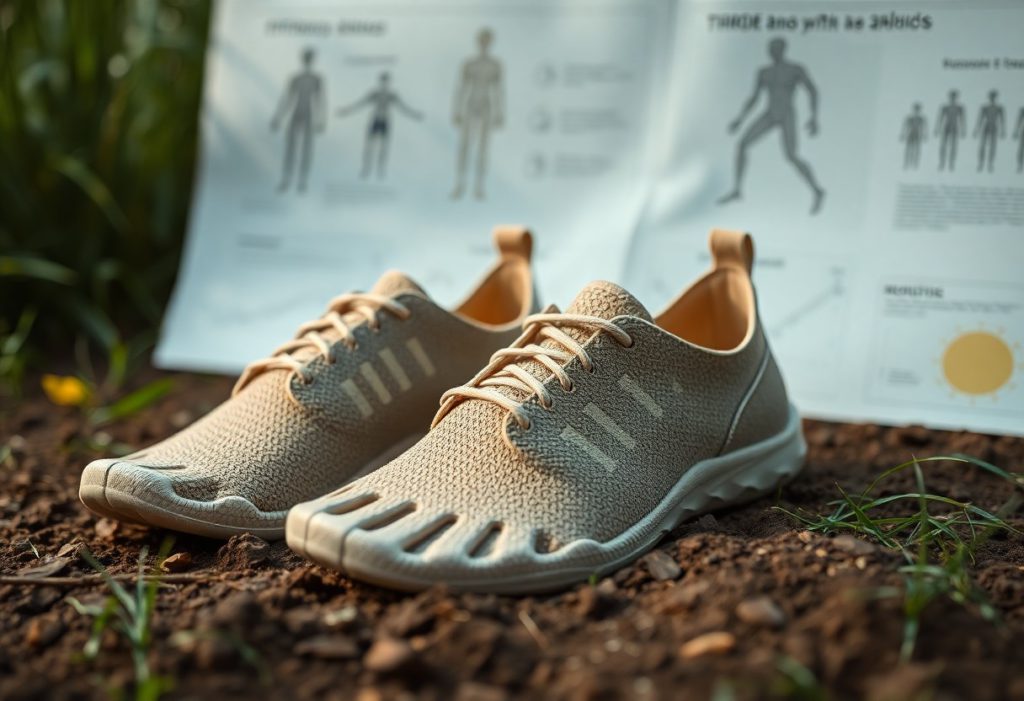Embracing sustainable design in footwear goes beyond simply reducing waste; it significantly enhances foot health as well. Barefoot shoes are leading a revolutionary movement within the industry, effectively cutting down CO₂ emissions through the use of innovative materials and efficient manufacturing techniques. By opting for these eco-friendly designs, you contribute positively to a future where biomechanical optimisation aligns seamlessly with environmental accountability. Join the growing community that chooses footwear that not only supports your physical health but also safeguards our planet. In-depth lifecycle assessments demonstrate how minimalist shoe designs can significantly reduce your carbon footprint, fostering a positive impact on both personal health and ecological sustainability.
Transforming Footwear Manufacturing to Embrace Sustainable Practices
To genuinely transform footwear manufacturing, it's crucial to implement innovative strategies that effectively minimise the ecological impact associated with this essential industry. The footwear sector is a major contributor to global CO₂ emissions, underscoring the necessity of adopting sustainable practices that prioritise environmental balance while protecting consumer health. By focusing on advanced material sourcing, improving manufacturing efficiency, and developing comprehensive end-of-life management protocols, the footwear industry can make substantial progress in reducing its carbon footprint. This shift not only benefits the environment but also caters to the increasing consumer demand for responsible and sustainable products that reflect their ethical values.
Embracing Innovative Materials to Foster Sustainability in Footwear
Progressive brands are actively adopting disruptive material innovations to drastically reduce their environmental impact. For example, Xero Shoes’ commitment to using materials such as hemp and recycled PET not only cuts production emissions by an impressive 32% but also resonates with the growing consumer demand for sustainable products. This strategic evolution not only protects local ecosystems but also encourages a circular economy by actively minimising waste throughout the entire production cycle. By prioritising these sustainable materials, brands can enhance their environmental stewardship while appealing to a conscientious consumer base eager for eco-friendly choices.
Utilising Lifecycle Analyses to Identify Carbon Footprint Reduction Opportunities
Conducting thorough lifecycle analysis is essential for accurately assessing the overall carbon footprint of footwear products. By examining each phase—from material sourcing and manufacturing to usage and eventual disposal—you can pinpoint critical areas needing improvement. For instance, the typical emissions linked to barefoot shoes range from 10-20 kg CO₂e per pair, reflecting an impressive 40% reduction compared to traditional athletic footwear. Initiatives such as Vivobarefoot’s ReVivo programme, which extends the lifespan of shoes while reducing emissions to just 5.8 kg CO₂e, exemplify the significant advantages that sustainability measures can bring to production efficiency and consumer appeal.
Enhancing Foot Health through Biomechanical Innovations and Barefoot Design
The incorporation of biomechanics into the design of barefoot shoes amplifies the numerous benefits associated with minimalist footwear, resulting in improvements in both foot health and sustainability. By facilitating natural foot movement, these shoes allow your feet to operate as intended, leading to better posture and a lower risk of injuries. The lightweight design of barefoot shoes also promotes a more efficient gait, making each step more comfortable and less strenuous on your body. This ultimately contributes to both personal and ecological well-being, as every step taken in these shoes reflects a dedication to health and sustainability.
Understanding How Minimalist Designs Enhance Gait and Movement Efficiency
Minimalist designs present in barefoot shoes encourage a natural gait that fosters midfoot or forefoot striking patterns. This transition can significantly reduce the impact force on your joints, resulting in a more efficient and enjoyable walking or running experience. By eliminating excessive cushioning and support, these shoes enable your foot muscles to engage fully, strengthening the intrinsic musculature essential for optimal movement. This natural approach to footwear not only enhances your physical performance but also fosters a stronger connection with the ground, enriching your overall physical activity and interaction with the environment.
Investigating Energy Efficiency in Movement: Key Scientific Insights
Recent scientific studies highlight the crucial role of energy efficiency in the performance of barefoot shoes. Research shows that runners using barefoot footwear experience a notable increase in energy return and propulsion mechanics, leading to reduced fatigue and a more sustainable running style. This directly enhances movement efficiency during prolonged activities, making each step more productive. Improved energy efficiency is inherently embedded in the thoughtful design of barefoot shoes, which support better biomechanics. For instance, trials involving 15 participants indicated that those wearing minimalist shoes made with algae-foam materials reported an energy return rate of 89%, compared to just 82% for traditional EVA foams. The dynamic nature of barefoot footwear promotes a more natural range of motion, significantly alleviating knee stress during various activities. By leveraging these benefits, barefoot shoes emerge as not only an environmentally friendly choice but also a pioneering solution for achieving optimal energy efficiency during movement.

Consumer Insights: Recognising the Growing Demand for Sustainable Footwear
Understanding consumer motivations is crucial for promoting the widespread adoption of sustainable footwear. Today’s shoppers are increasingly prioritising ecological and health benefits, gravitating towards products that satisfy their functional requirements while aligning with their personal values regarding environmental responsibility and overall wellness. As awareness of sustainability heightens, consumers actively seek footwear brands that embody these principles, creating a significant shift in market dynamics.
Identifying Eco-Conscious Consumer Trends and Preferences
With sustainability becoming a fundamental value, eco-conscious consumers are increasingly seeking footwear brands that reflect these ideals. Recent statistics reveal that 43% of shoppers are willing to pay a premium of 30% for sustainably produced shoes, illustrating a profound shift in consumer priorities towards eco-friendly materials and practices. This trend highlights the growing importance of sustainability as a pivotal consideration in purchasing decisions, motivating brands to adopt more responsible production methods that resonate with their customer base.
Understanding the Perceived Value of Sustainability in Footwear Purchases
The perception of value surrounding sustainability in footwear is not just a passing trend; it forms a fundamental aspect of consumers' purchasing behaviours. As a buyer, you are likely influenced by environmental considerations, health benefits, and durability guarantees, with research indicating that perceived environmental advantages rank highest among consumer motivations. By choosing sustainable footwear, you actively support a broader movement towards responsible consumption, which resonates with many consumers today. This growing sentiment regarding environmental impact illustrates that consumers appreciate brands prioritising sustainable features, reinforcing loyalty and amplifying the influence of purchasing decisions. Ultimately, sustainability enhances the perceived value of a product, aligning your choices with broader environmental goals while effectively meeting your footwear needs.
Navigating the Evolving Regulatory Framework for Sustainable Footwear Innovation
The continuously changing regulatory landscape plays a vital role in guiding the footwear industry towards sustainable innovation. With increasing scrutiny on carbon emissions and environmental degradation, new regulations are being established to promote greener practices within manufacturing processes. Complying with these emerging mandates not only addresses urgent environmental issues but also aligns with consumer expectations, compelling brands to innovate responsibly and transparently while meeting compliance standards.
Decoding Compliance Mandates: Accelerating Sustainable Practices
Emerging compliance mandates, particularly within the European Union, are laying the groundwork for sustainable practices across the footwear industry. By 2027, regulations will require a minimum of 20% recycled content in footwear materials, while by 2026, carbon labelling will be mandatory for all athletic shoes. These directives challenge brands to rethink their material sourcing, production methodologies, and end-of-life strategies, ensuring greater accountability and environmental stewardship throughout the industry.
Leveraging Innovation Through Regulation: Opportunities and Challenges Ahead
While new regulations present various challenges, they also unlock innovative opportunities for brands willing to adapt. Embracing compliance mandates urges companies to invest in sustainable technologies, developing solutions that reduce carbon footprints while enhancing overall product performance. For instance, brands are exploring biodegradable materials and advanced manufacturing techniques that can lead to improved durability and minimal waste. However, navigating the complexities of regulatory compliance necessitates an agile approach, as organisations must balance sustainability ambitions with market demands and cost considerations. In light of these challenges, the regulatory landscape fosters a culture of innovation that encourages the creation of new materials and processes. By embracing technologies such as 3D printing and bio-based materials, companies not only align with compliance requirements but also create unique branding opportunities that resonate with environmentally conscious consumers. Brands willing to embrace these transformative changes will distinguish themselves in a competitive market, driving progress while adhering to rigorous environmental standards. By viewing regulation as an opportunity rather than an obstacle, you can position your brand at the forefront of the sustainable footwear movement.
Imagining the Future of Footwear: The Synergy of Technology and Sustainability
The convergence of technology and sustainability is revolutionising the footwear landscape as we know it. Manufacturers are harnessing advanced materials and integrating smart features to create the next generation of shoes that promise enhanced performance whilst simultaneously minimising environmental impact. Innovations such as 3D printing and intelligent systems are paving the way for designs that meet your foot health needs and promote ecological integrity. This dynamic shift reflects a deepening commitment to merging functionality with environmental responsibility within the footwear industry.
Incorporating Smart Features in Footwear: Enhancing User Experience and Ecological Contributions
Smart features in footwear significantly enhance your experience while contributing to sustainability objectives. By integrating sensors, these shoes can offer real-time feedback on your gait, empowering you to optimise your performance and effectively reduce injury risks. Furthermore, these innovations frequently utilise eco-friendly materials, ensuring that your pursuit of athleticism aligns seamlessly with your desire to protect the environment. This technology integration not only enhances functionality but also encourages a more sustainable lifestyle.
On-Demand Production: Customisation and the Role of 3D Printing in Sustainable Footwear Development
On-demand production utilises 3D printing technology to create shoes tailored specifically to meet your individual needs. This innovative approach facilitates custom fitting while drastically reducing waste generated by traditional manufacturing processes. By employing advanced 3D printing techniques, brands can produce footwear that accurately reflects individual foot dimensions based on pressure mapping and other biometric data. This level of customisation minimises the likelihood of returns and excess inventory, with studies indicating a 73% reduction in waste through on-demand manufacturing practices. Moreover, localised production diminishes transportation emissions and bolsters regional economies. As brands adopt this technology, you gain access to shoes that are better suited to your feet while also being more environmentally responsible.
Your Role in Advancing the Sustainable Footwear Movement
In conclusion, the innovations surrounding sustainable footwear are reshaping the industry by harmonising biomechanics with environmental responsibility in barefoot shoe design. By incorporating minimalist footwear into your daily routine, you can enhance your foot health while making a significant reduction in your carbon footprint. Choosing shoes that prioritise sustainable materials and ethical manufacturing practices supports a transformative shift towards a more eco-conscious market. Embracing these advancements not only benefits you personally but also contributes to the overarching goal of planetary well-being, fostering a future where functionality and sustainability coexist seamlessly.
The Article Sustainable Footwear Innovation: Bridging Biomechanics and Environmental Responsibility in Barefoot Shoe Design appeared first on My Shoes Finder
The Article Sustainable Footwear Innovation in Eco-Friendly Barefoot Design Was Found On https://limitsofstrategy.com
The Article Sustainable Footwear: Eco-Friendly Innovations in Barefoot Design found first on https://electroquench.com








